Hailstones are getting biblical in sizes!
And hailstorms are getting more apocalyptic!
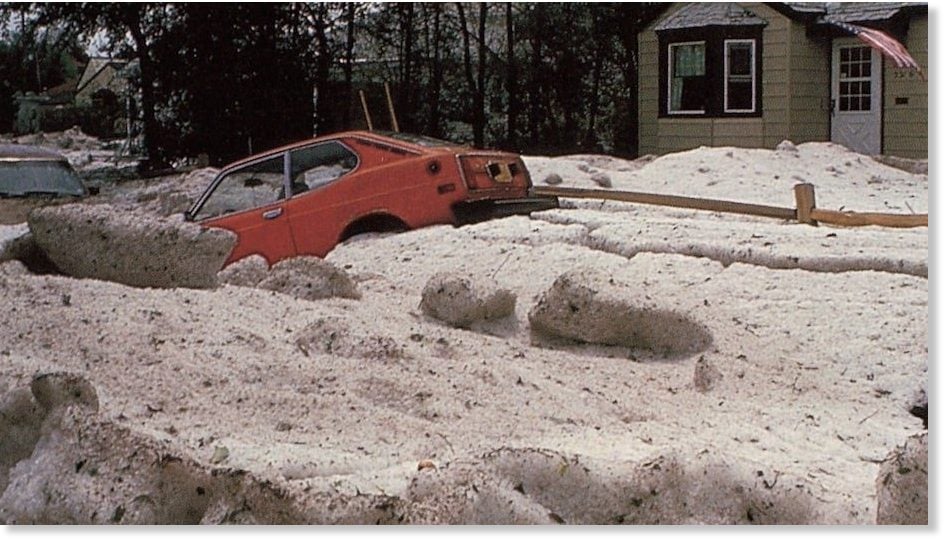
Recently, an investigation into a hailstorm that took place in Villa Carlos Paz, Cordoba Province, Argentina on February 8, 2018, reported that a hailstone some 9.3 inches in diameter may have fallen during a storm there.
The weather event has been documented in a February paper for the Bulletin of the American Meteorological Society entitled “Gargantuan Hail in Argentina.” The authors propose that hailstones larger than 6″ in diameter be classified as “gargantuan”.
If verified, the Argentine hailstone would surpass the U.S. record holder, an 8-inch-diameter stone collected near Vivian, South Dakota on July 23, 2010. That hailstone was said to have actually been 11″ in diameter before a portion of it melted prior to being officially measured. However, the Argentine hailstone will likely never become an official record, since its size was estimated only from video evidence and not from any first-hand measurements.
On Friday night, May 22, 2020, a hailstone of 5.33″ diameter was reported in Burkburnett, Texas:
With peak U.S. hail season at hand, here is a compilation of the costliest and deadliest hailstorms in U.S. history, along with a summary of the largest hailstones yet observed in the United States.
U.S. hailstorm climatology
Hailstorms in the U.S. normally occur during the months of May to August as opposed to tornado frequency peaking in April and May.
Snowden D. Flora, in his classic book Hailstones of the United States (1956), analyzed hailstorm events for the period 1944-1953 and found that 20.0% of all hailstorms in the U.S. took place in May, 24.9% in June, 21.9% in July, and 18.0% in August (in other words, 85% during this four-month time period).
This finding holds up well next to a radar-based climatology for 2007-2010 published in the journal Weather and Forecasting, which found that “June is clearly the leading month for severe hail.”
The portions of the country that are most likely to experience hailstorms (especially those that produce very large hail) are somewhat similar to the areas most affected by tornadoes.
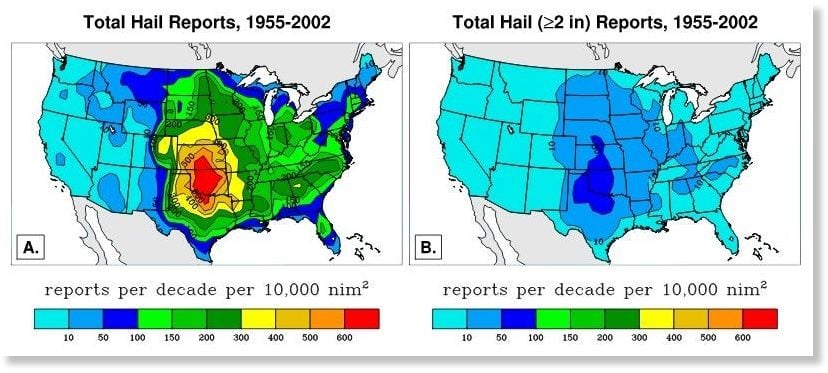
The National Weather Service (NWS) uses a variety of analog objects to describe the various sizes of hailstones reported to their offices.
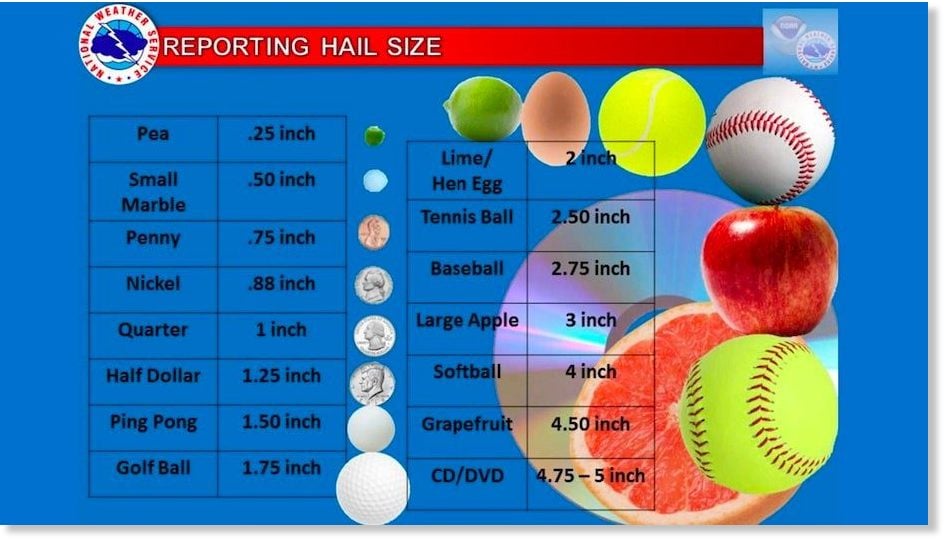
Costliest U.S. hailstorms
It is now estimated that in the U.S. hailstorms cause an average of $15 billion in damage to homes, cars, and crops each year.
This total has greatly increased in recent decades: the estimate for the 1990s was $1.2 billion per year, and that itself was an increase over prior decades.
Some factors behind the rapid increase include population growth in hail-prone areas such as Denver and Dallas – Fort Worth and the larger size of many newer homes. The costliest year to date was 2017, when insurers reported $22 billion in hail damage.
A handful of hailstorm events in the recent past have resulted in $1 billion or more in damages (2020 USD).
Phoenix experienced the single most damaging hailstorm in U.S. history on October 5, 2010, with a tab of $3.2 billion (adjusted to 2018 dollars).
“Some homeowners had to wait more than a year before a licensed contractor was available to repair their roofs,” said meteorologist and operations analyst Bryan Wood (Assurant) in a Capital Weather Gang essay.
Another extremely costly storm was that of April 10, 2001, which cut a swath along the I-70 corridor from eastern Kansas to southwestern Illinois and pounded the St. Louis area. Property damage was in excess of $2.5 billion in 2020 dollars.
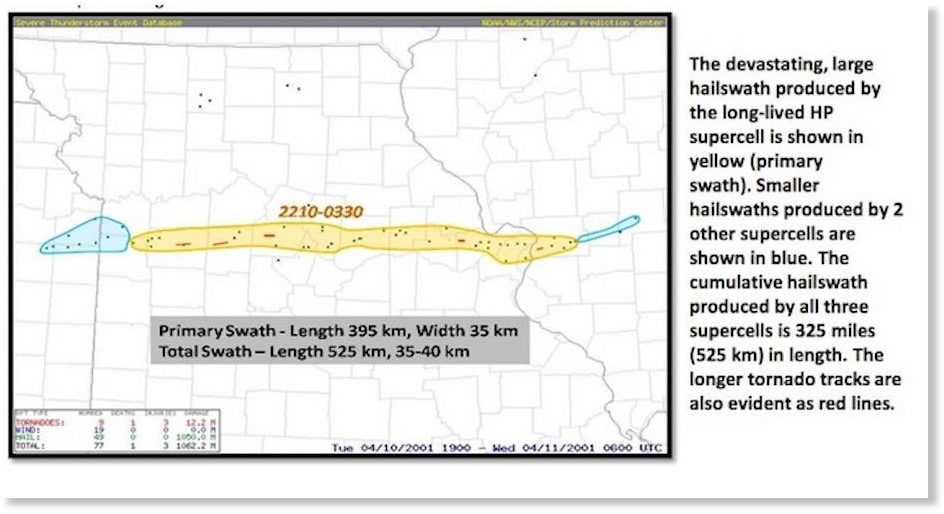
The St. Louis area was once again pounded by a series of hailstorms on April 26, 2012, causing $1.6 billion in property damage. The so-called Mayfest Hailstorm that pummeled Tarrant and Dallas Counties (Dallas – Fort Worth) in Texas on May 5, 1995, caused an estimated $2 billion in damage (USD 2020). The same area was hit again by a destructive hailstorm on March 23, 2016, resulting in $2.2 billion in damage. Again, also in Texas, a hailstorm hit San Antonio on April 16, 2016, resulting in $1.4 billion in damage, with hailstones the size of grapefruits.
Other $1 billion+ hailstorms include three events that pummeled the Front Range of Colorado. One event occurred between Colorado Springs and Fort Collins on July 11, 1990, causing $1.6 billion damage (USD 2020). Another affected the Denver metropolitan area on May 8, 2017, causing an estimated $2.0 billion in damage. Yet another, on July 7, 2009, in Jefferson County, caused $1.2 billion in damage. It should be noted that in some of the above cases high winds also contributed to the damage totals and are not necessarily separated from the actual hail damage costs.
Deadliest U.S. hailstorms
In spite of the enormous crop and property damage that hailstorms cause, only three people are known to have been killed by falling hailstones in modern U.S. history:
- A farmer caught in his field near Lubbock, Texas on May 13, 1930;
- A baby struck by large hail in Fort Collins, Colorado, on July 30, 1979;
- A boater on Lake Worth, Texas, on March 29, 2000.
Largest U.S. hailstones
The largest officially recognized hailstone on record to have been “captured” in the U.S. was that which fell near Vivian, South Dakota on July 23, 2010. It measured 8.0″ in diameter, 18.5″ in circumference, and weighed in at 1.9375 pounds.
Lee Scott, who collected the monster stone, said that he had originally planned to make daiquiris out of the hail, but fortunately thought better and placed it in a freezer before turning it over to the National Weather Service for certification. The hailstone ended up at the National Center for Atmospheric Research (NCAR). The journal Weather has a detailed account of the investigation into this event.

The National Weather Service had this to say about the Vivian hailstone: “The reported value has been evaluated by the National Climate Extremes Committee and found to be accurate. This hailstone is the heaviest and greatest diameter stone on record for the United States. When initially collected after the storm, the stone had a reported diameter of 11 inches, but deteriorated in the observer’s freezer owing to a loss of power after the storm.”
Other instances of 8-inch-diameter hail have been reported in the past but not certified. The U.S. Weather Bureau’s Climatological Data by Sections Vol. 22, Part 2 (April-June 1935) mentions a hailstorm producing 8-inch-diameter hailstones near Ponca City, Oklahoma, on April 17, 1935. A report published in the New York Times on December 27, 1892 (apparently initially printed in the Galveston News) claimed hail of 8″ in diameter fell at Gay Hill, Texas, during a storm on December 6, 1892.
More recently, what would have been the largest hailstone in U.S. history if not for the Vivian event was a 7.75″-diameter hailstone collected in Wichita, Kansas, following a storm on September 15, 2010. Note that this happened less than two months after the Vivian event!
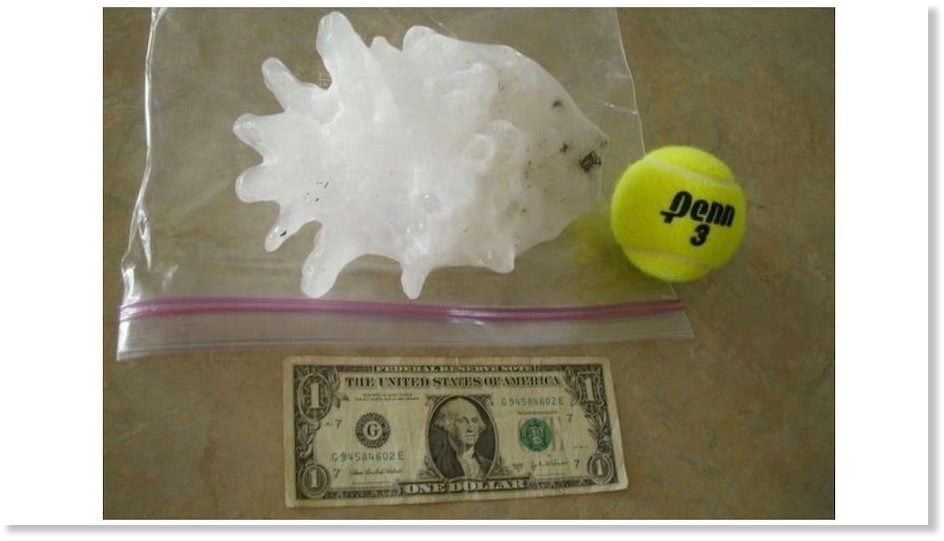
Below is a list of the largest hailstones ever measured for each state. Only a few states maintain an “official” list of such records for hail (as noted in SCEC reports), which I note first in the table and then followed by a list of ‘unofficial’ sizes by state. I have gathered these reports from various sources. If any readers could add to this list or correct it, it would be much appreciated!
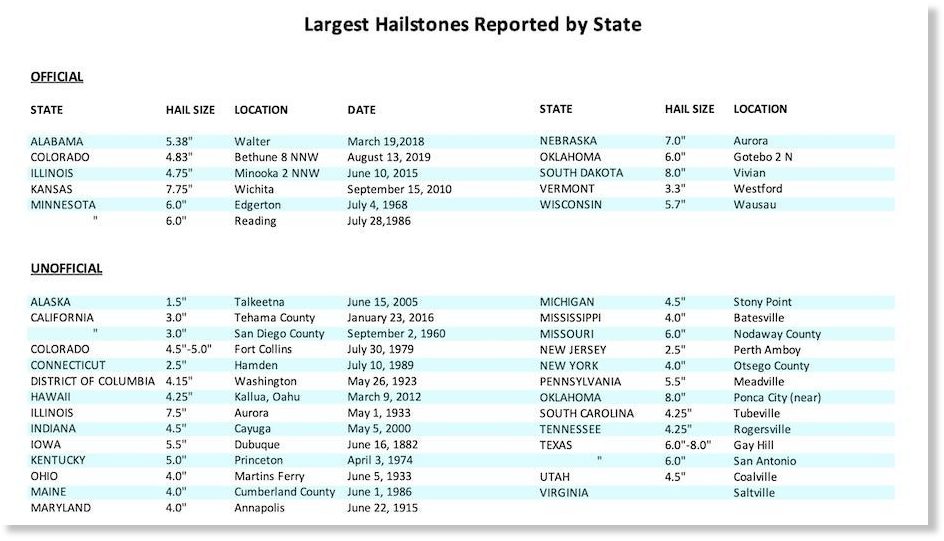
Hail accumulations
Some hailstorms train over the same area (as stationary or slow-moving thunderstorms develop), producing massive hail accumulations. Hail accumulated 18″ deep on level in Seldon, Kansas, on June 3, 1959, perhaps the greatest on-level hail accumulation on record in the U.S.
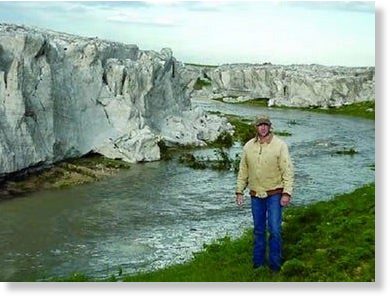
As shown in the image at top, rainfall during or following a hailstorm can cause hail accumulations to wash into ditches, creek beds, or other low-lying areas, resulting in enormous piles of hail often several feet deep. This was the case during a storm south of Clayton, New Mexico on August 13, 2004 when a 12″ hail accumulation was swept into a draw by 5″ of rainfall. A culvert in the draw became clogged by the flow and the hail piled up to an astonishing 15 feet behind it!
I tell you, we will soon get submerged by rivers of hail or knocked down by huge ice boulders dropping from the sky! Be ready and get prepared. More apocalyptic weather news on Strange Sounds and Steve Quayle.












